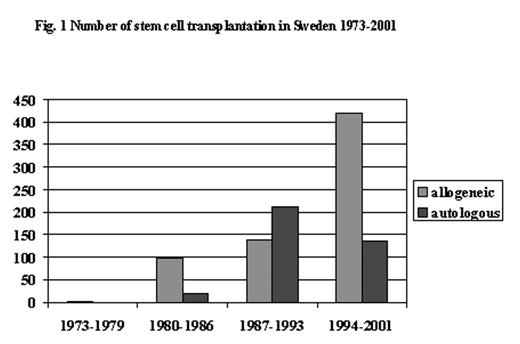Abstract
Background
AML is an aggressive disease, which is rapidly fatal without specific therapy. Such treatment was not available until the early 1970’s when combinations of anthracyclines and cytarabine were introduced. Since then major improvements have been made in chemotherapy, stem cell transplantation (SCT) and supportive care. The aim of this study was to define the impact of modern AML treatment strategies on outcome. Extrapolation of results from clinical trials may not be appropriate for estimation of outcome in the whole population because of a varying degree of patient selection. In this study relative survival rates (RSR) were estimated in relation to age, sex, calendar period and region of residence in a cohort of 5,809 AML patients.
Methods
Records on all patients with AML reported to the Swedish Cancer Register between 1973 and 2001 were linked to the nationwide Cause of Death Register. Information on the number of SCT in AML patients in Sweden during the study period was obtained from the EBMT register. Survival analysis were performed by computing relative survival rates (RSR), defined as the ratio of observed survival of the patients in the cohort versus the expected survival among individuals of the same age, sex, and calendar year of observation.
Results
5809 AML patients diagnosed between January 1, 1973 and December 31, 2001 were identified. The cases were divided into six age groups; 0–18, 19–40, 41–60, 61–70, 71–80, and 80+ years. The study period was arbitrarily divided into 7-year intervals. Improvement was seen in all age groups but the eldest. However, patients < 60 years benefited most from new treatment strategies (table 1).
There was a marked increase in SCT during the study period with allogeneic SCT dominating in the last period (fig 1). A comparison between regions (with different therapeutical traditions) was made. The regions of Stockholm, Uppsala and Örebro have cooperated since 1971 within the Leukemia Group of Middle Sweden (LGMS) and was therefore considered as one region and compared with the rest of the country. During the first calendar period the 5-year RSR of residents with AML in LGMS counties was significantly higher than that of patients in remaining regions. However, this difference has disappeared with time.
Conclusion
Improvement in overall survival of AML patients was mainly confined to young patients (<60 years). However, among patients 60–71 years at diagnosis, a slightly improved RSR was observed. For patients above the age of 70 years, the prognosis remains very poor stressing the fact that the decision to use aggressive chemotherapy for this group of patients should consider the risk of iatrogenic morbidity and mortality as well as projected benefit. The early creation of a cooperative clinical AML group probably explains the improved RSR rates during the first study period (1973–1979).
Five-year RSR (%) according to age group and calendar period
| calendar period/age group (years) . | 1973–1979 . | 1980–1986 . | 1987–1993 . | 1994–2000 . |
|---|---|---|---|---|
| 0–18 | 17 | 31 | 52 | 68 |
| 19–40 | 14 | 17 | 38 | 58 |
| 41–60 | 7 | 13 | 22 | 36 |
| 61–70 | 6 | 8 | 12 | 15 |
| 71–80 | 3 | 3 | 7 | 6 |
| 81+ | 1 | 0 | 0 | 1 |
| calendar period/age group (years) . | 1973–1979 . | 1980–1986 . | 1987–1993 . | 1994–2000 . |
|---|---|---|---|---|
| 0–18 | 17 | 31 | 52 | 68 |
| 19–40 | 14 | 17 | 38 | 58 |
| 41–60 | 7 | 13 | 22 | 36 |
| 61–70 | 6 | 8 | 12 | 15 |
| 71–80 | 3 | 3 | 7 | 6 |
| 81+ | 1 | 0 | 0 | 1 |
Author notes
Corresponding author


This feature is available to Subscribers Only
Sign In or Create an Account Close Modal